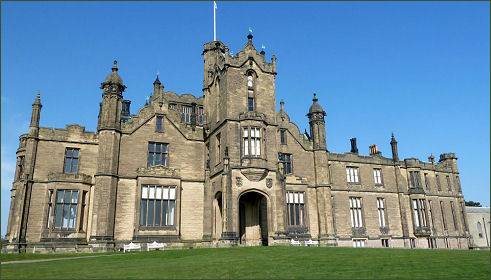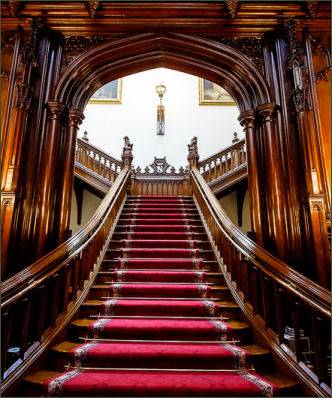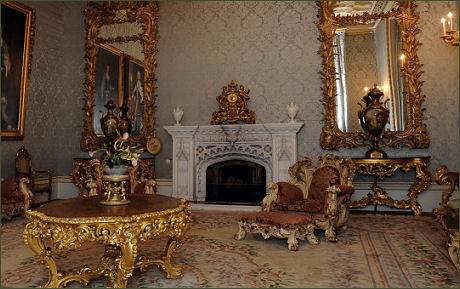Allerton Castle
OS grid reference:-

 Allerton Castle is a Victorian Gothic house and is situted at Allerton Mauleverer in North Yorkshire, some ten miles(16 km) to the east of Harrogate
Allerton Castle is a Victorian Gothic house and is situted at Allerton Mauleverer in North Yorkshire, some ten miles(16 km) to the east of Harrogate
Formerly known as "Allerton Park" Allerton Castle is Grade I listed and was rebuilt by George Martin in 1843-53. The site on which Allerton Castle stands has a history going back to the Norman Conquest, when it was owned by the Mauleverer family. The founder of the family was William Mauleverer who came to England with William the Conqueror and fought at Hastings. The nearby church of St Martin contains several tomb-monuments to the family.
When Richard Mauleverer died without an heir in 1692, Allerton passed to his wife and the estatewas later inherited by Richard Arundell, her son by her second marriage. Arundell, who was Member of Parliament for Knaresborough, rebuilt the house in the 1740s, and in 1745 remodelled St Martin's Church, which stands outside, in Norman revival style. The mid-eighteenth century interior of the church remains unaltered to the present.
After Richard Arundell's death in 1758, Allerton passed to Viscount Galway, whose son sold it in 1786 to Prince Frederick, Duke of York, the second son of King George III and brother of King George IV. Prince Frederick rebuilt the house to designs by Henry Holland. He also constructed the Temple of Victory, a fine octagonal building of Palladian design, which is visible from the A1 on a 200-foot (61 metre) high hill. According to local legend, the activity of workers constantly ascending and descending to build the mound, provided the inspiration the the famous nursery rhyme about the Grand Old Duke of York and his 10,000 men. Prince Frederick sold the estate shortly afterwards in 1789.
The estate changed hands yet again in 1805 when it was purchased by Charles Philip Stourton, 17th Baron Stourton. The Hon Edward Stourton's family (the Lords Mowbray) owned the house from 1805 to 1983, when it became known as 'Stourton House', and the Catholic peer added a chapel in Gothic style. However, in 1843 his son demolished the Georgian house and emloyed George Martin to build the present house in a Tudor-Gothic style. In 1856 work halted due to lack of funds to complete all the interiors. The house was used by the Royal Canadian Air Force during World War II and in 1965. The family ceased to live there after the death of the 22nd Baron Stourton. The contents were sold off in 1965.
In 1983 the house was purchased Dr Gerald Rolph, an American businessman. The purchase included the house and gardens, but not the surrounding park which was retained by Lord Mowbray. Dr Rolph renovated the building to a high standard, filling the house with furniture and pictures of appropriate scale and splendour. The estate is now run by the Gerald Arthur Rolph Foundation for Historic Preservation and Education, and rooms are available to hire for corporate events and weddings.
A terrible fire in January 2005 caused substantial damage to the north aspect of the castle, including the main dining room, library, rear entrance hall, two bedrooms and adjoining dressing rooms and bathrooms and the Servants' Wing. Restoration work commenced in the spring of 2006 and is now more or less complete. The restoration work by specialist contractors consisted of substantial repairs to the ornate stonework and windows, the installation of new floors at first, second and attic levels, significant steelwork, and a new roof structure to match the existing roof. Electrical, plumbing and heating installations as well as plasterwork were also renewed.
 The main block is constructed of dark-coloured stone, with a high tower rising above the entrance porch. The lower brick range to the right houses the Chapel of 1805, and behind are the lower buildings of the service courtyard, dating from the eighteenth century.
The interior of Allerton Castle was designed on a vast scale, with late-Gothic decoration in the style of Pugin's work on the Palace of Westminster. The early-Victorian craftsmanship and the recent restoration work are of the highest quality.
The galleried great hall is one of the highest such baronial halls in England, almost 70 feet (21 metres) high, lit from a huge lantern which rises from the centre of the main block. It is adorned by intricately carved oak panelling lit by stained glass windows, and has galleried landings whose walls are hung with full-length portraits including works by Michael Dahl and William Dobson.
The main block is constructed of dark-coloured stone, with a high tower rising above the entrance porch. The lower brick range to the right houses the Chapel of 1805, and behind are the lower buildings of the service courtyard, dating from the eighteenth century.
The interior of Allerton Castle was designed on a vast scale, with late-Gothic decoration in the style of Pugin's work on the Palace of Westminster. The early-Victorian craftsmanship and the recent restoration work are of the highest quality.
The galleried great hall is one of the highest such baronial halls in England, almost 70 feet (21 metres) high, lit from a huge lantern which rises from the centre of the main block. It is adorned by intricately carved oak panelling lit by stained glass windows, and has galleried landings whose walls are hung with full-length portraits including works by Michael Dahl and William Dobson.
The hall is central and gives access to the elegant drawing room, the blue-and-white ballroom, and the library with bookcases based on the original designs and restored in the on-site workshop. Most of the original bookcases, together with the books, were destroyed in the fire. The wallpaper was based on one of Pugin's designs for the Houses of Parliament and the ceiling has recently been repainted in the original colours. The principal staircase opens off the great hall, under another vaulted ceiling hung with portraits of the Mowbray and Stourton families.
The library and dining room occupy the north side of the Hall. The dining room is panelled and has stained glass windows with the arms of the Mowbray and Stourton families. On the huge table, original to the house, are candelabra dating from 1848. The drawing room has a magnificent plaster ceiling. On the walls are portraits by Michael Dahl and Charles Jervas, and vast rococo mirrors, made for Melton Constable Hall in Norfolk. The ballroom, in the west of the house, was left with bare masonry by Lord Mowbray and Stourton, but Dr Rolph has decorated it with a plaster vaulted ceiling. On the entrance-side of the house are the Billiard Room, the Music Room, housing a collection of late m nineteenth and early twentieth century automatic musical instruments, and the Morning Room.
Allerton Castle will be open to visitors for guided tours of the main floor rooms on Wednesday afternoons and Bank Holiday Monday afternoons from Easter Monday through to the end of October 2016. Each tour takes approximately 90 minutes.
Directions
Located just off junction 47 of the A1; close to Harrogate, York and Leeds.
